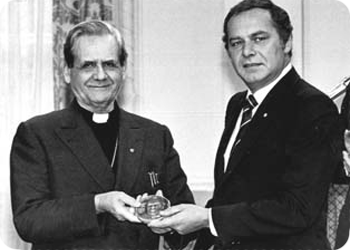Paul-Émile Cardinal Léger
On October 24th 1979, a brief ceremony was held at Rideau Hall in Ottawa to mark United Nations Day and the inauguration of the Pearson Peace Medal. Intended as an annual event, the first person chosen to receive the medal was Paul-Émile Cardinal Léger.
George Ignatieff, the National President of the UNA read the following citation in his honour: “In presenting his Eminence Cardinal Léger as the first recipient of the Pearson Peace Medal… the jury has chosen a great churchman, who by his personal example of self-sacrifice, especially in service among the most deprived and suffering abroad, has been deemed worthy of the high aims and standards set by him whom this award seeks to commemorate.
The Merits and achievements of the Rt. Honorable Lester B. Pearson are well known, especially his record as world statesman. This won him world recognition and the distinction of being the only Canadian to have been awarded the Nobel Peace Prize. Since this record was so closely associated with the United Nations, the Association of which I am President, wished to commemorate for future generations what L.B. Pearson worked for.”
“Especially at this time, when the compulsion of cooperation and interdependence brought on by revolutions in technology that can foster the good life if threaten our survival, stand in such contrast with a prevailing mood of self-seeking on the individual and national plane, it is appropriate that the medal should go to one, who by personal example showed a willingness to give up so much for those who need compassion and help the most. His actions represented a modern reenactment of the Good Samaritan in a global setting, which inspires his fellow-Canadians.”
Also taking part in the ceremony at Government House was Captain Joseph Jeffrey, Chairman of the 1979 National UN Day Programme, who spoke briefly about the aims of the UN Association in Canada.
The Pearson Peace Medal was instituted this year by the UNA in order to heighten awareness among Canadians about the cause of international understanding and cooperation. The Medal itself was cast in silver and was designed by Dora de Pedery-Hunt of Toronto, likely Canada’s most illustrious sculptress of fine-cast medals.
Cardinal Léger resigned in 1967 after years of service as Archbishop of Montréal to work with the poor and handicapped in West Africa. There, through his organization, Cardinal Léger and his endeavours, he built a rehabilitation centre for handicapped children, a refuge for lepers, a clinic for the world poor, a housekeeping school for young women, a home for the elderly and a home for widows. In August of 1979, he returned home to aid in the resettlement of Asian refugees in this country. he was recently named, with former Governor-General Roland Michener, co-chairman of the Canadian Foundation for Refugees.
The final word should be given to the Ottawa Citizen which editorialized “Léger and Pearson were very different in most ways. But both served the cause of man, one by promoting peace, the other by lessening his suffering.
The work of both men is an inspiration to Canadians – reminder that we belong to the family of man and nothing in life is more important than doing what we can for those less fortunate than we are.”







